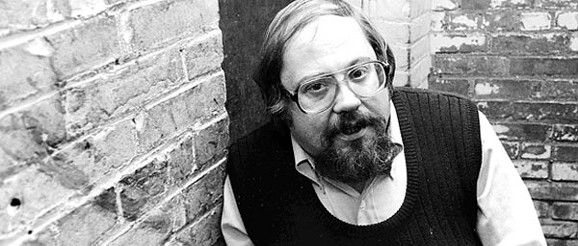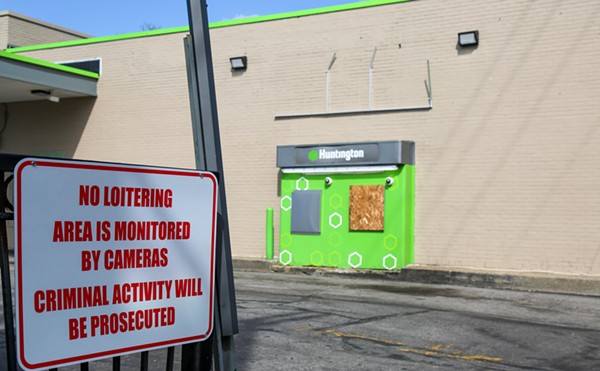Frank Mauceri likes to say that his office is wherever his laptop happens to be. Today, it's New York City for the owner of Smog Veil Records. The Greenwich Village brownstone where he and his wife Lisa occasionally live might not have all the trappings of a record label office but it's not your typical flat either. A few Shepard Fairey "Obey" prints hang in the living room. In the master bedroom, prints by Devo singer Mark Mothersbaugh feature a cute little girl whose face looks more like a ghoul than an Alice in Wonderland stand-in.
"Come Alive! Join the underground generation," reads an Allen Ginsberg poster that shows a bearded Ginsberg with his arms extended high into the air, a red, white and blue hat balanced precariously atop his head. That sentiment could pass as Smog Veil's mission statement. The label specializes in reissuing old Cleveland punk bands, and Mauceri has also signed a number of new Cleveland punk acts over the years. When the label first launched in 1991, it released a 7-inch by now-legendary local hardcore heroes the Spudmonsters. More recently, it's put out albums by the garage blues band Obnox and art punk noisemakers This Moment in Black History, two of the city's best punk/garage/indie rock acts.
Though Mauceri, who grew up on Cleveland east side, rarely comes to Cleveland — he visits his parents in Lake County a couple times a year — Smog Veil has done much to nurture the local scene. That continues with Smog Veil's latest and most ambitious project yet: Mauceri and company have launched a special reissue campaign dubbed Platters du Cuyahoga.
The series commences this month with the release of Albert Ayler's Ghosts Live at the Yellow Ghetto, a studio effort from the art-punk band X_X. Two more albums in the first series — Robert Bensick's French Pictures in London and the Mr. Stress Blues Band's Live At the Brick Cottage 1972-73 — will come out in early 2016. Each release will arrive on vinyl and be accompanied by extensive liner notes put together by Andrew Russ and Nick Blakey, a sharp research team Mauceri has hired specifically for the project.
"There's a big demand for archival releases from Cleveland, and there's a lot of great Cleveland-produced music that either never got released or has been out of print forever," says Mauceri, who, with his round glasses, mutton chops and receding hairline, looks a bit like an older, hipper Harry Potter.
"There's this great treasure trove of recordings out there that I can draw upon," he continues. "For me, each of these records has a story behind it. It's more than putting out a record with 10 songs and a fancy cover. It's important to tell the story. There's a great history behind each of the records, and we want to bring the record out of the vacuum that exists and into a reality. All the records were not only underappreciated in their time, but they're relevant today and serve as a commentary about where Cleveland is now and where it's heading."
Andrew Russ, one half of the research duo, holds down a day gig as a research engineer/scientist at the Ohio Research Institute for Transportation and the Environment at Ohio University. He regularly sifts through back issues of The Plain Dealer to track down old reviews and stories: He's even tracked down the original classified ad that brought Rocket from the Tombs together. He and the tall, stocky Blakey, a guy who grew up in San Francisco, where he ended up hanging out in record stores and receiving what he dubs "a real education," have helped guide the project.
"I would rather read about bands like the Rolling Stones, the Beatles, the Kinks and the Who than throw a football when I was a kid, which confounded my father," says Blakey, who's taken a train into Manhattan to join Mauceri today as he discusses the series' impending launch. They're decked out in sneakers, blue jeans and T-shirts and look like a pair of overgrown teenagers as they sit on a plush blue sofa and dish on the extensive time they've devoted to Platters du Cuyahoga and the motivation for unearthing long-lost gems.
"I now work at the record store In Your Ear," says Blakey, who appropriately enough talks about rock 'n' roll history with a scholar's acumen. "We can't keep classic rock in stock. We can't keep Pere Ubu in stock. We can't keep anything related to Detroit or Cleveland in the '70s in stock."
It All Starts with the Eels
Historically, Cleveland's role in punk rock's development might rank with that of major epicenters such as New York and London. In Clinton Heylin's 1993 book From the Velvets to the Voidoids: A Pre-Punk History for a Post-Punk World, Cleveland figures strongly. "Cleveland was the only U.S. city to have a contemporary wave of pre-punk exponents," Heylin writes. In the book, he interviews various members of Cleveland's formative punk bands and tells the story of how the electric eels, Mirrors, Rocket from the Tombs, Pere Ubu and the Dead Boys went against the grain and emerged from a steel town best-known as a classic rock hotbed.
When electric eels formed in 1972, guitarist John Morton — who currently leads X_X — would try to antagonize people by walking around town with bleached-blonde hair, wearing eye shadow and earrings. A frustrated art student who would drag lawn mowers and sheets of metal onstage in order to break from convention, Morton loved to push the boundaries of performance art. The band's single "Agitated"/"Cyclotron" wasn't issued until 1978 when the British label Rough Trade put it out at the recommendation of rock scribe Jon Savage. With its snotty vocals and snarling guitars, the single represents punk rock in its most primal form.
"You could say in hindsight that they were the first punk band, but I don't know," Scat Records owner Robert Griffin told us in a 2002 interview. "Does it make a difference if the monkeys know they're typing Shakespeare? It's almost a metaphysical question."
Morton, who now lives in upstate New York and works as an artist, often cites Charlotte Pressler, wife of the late Rocket from the Tombs singer-guitarist Peter Laughner, who once said that Cleveland was promised the end of the world but didn't get it. That, along with a healthy dose of late-night TV host Ghoulardi, a guy whose motto was "stay sick," helped fuel the discontent you hear in much of the punk music that emerged from Cleveland in the '70s. That motto inspired acts such as the Cramps, who issued an album called Stay Sick in 1990.
"We didn't know what we were doing," says Morton. "I know that for myself and the electric eels, I wanted to make music for myself. I had to feel good about it. I have always followed that. I always like provocation. I'm like a trickster. Let's get it going. Free jazz [is] angry, confrontational music. Albert Ayler couldn't have picked something to make his career worse. What is something that people will hate and disdain? It's very much the same with punk music. Let's do something aggressive and angry that's not easy to listen to. That's what I chose."
Anger and aggression can certainly be found in the music of Rocket from the Tombs, a band that would eventually spawn Pere Ubu and the Dead Boys. Rocket from the Tombs' singer David Thomas and Cinderella Backstreet singer-guitarist Peter Laughner would leave Rocket and join guitarist Tom Herman, bass guitarist Tim Wright, drummer Scott Krauss and synthesist Allen Ravenstine to form Pere Ubu in 1975.
One of the band's early "hits" was a rendition of Rocket from the Tombs' "Final Solution," a nihilistic song about not fitting in and wanting an end rather than a cure. Laughner would eventually leave the band and die from pancreatitis at age 24. "Peter's death was the end of an era for me," writes rock critic Lester Bangs. "An era of the most intense worship of nihilism and deathtripping in all marketable forms."
Back in 2002, Smog Veil Records released The Day the Earth Met the Rocket from the Tombs, a compilation of the band's best tunes, and gave the band a second life. The group has been touring and recording ever since.
"Those who were involved in the time, like me, are interested because it is part of our lives and we were dedicated to music and rock music, especially as a language, as an art and as a means of finding adulthood/meaning/substance," Tombs singer David Thomas once explained in an email exchange we had with him. "The people inside of something have different motivations and perspectives to the people outside, especially in a secretive craft like music. You are outside. I can't answer for why you or anyone else should think it matters. It's not my problem."
Russ has a more straightforward explanation for why underground music blossomed in Cleveland in the '70s.
"Ghoulardi introduced mayhem to local TV, and it rubbed off on an impressionable set of Cleveland youth," he says. "Michael Weldon in Mirrors started a magazine dedicated to those B-movies. That's definitely a factor. A lot of bands would come through Cleveland and by the mid-'70s, it became the place to start your tour if you're trying to break big in America. It certainly worked for David Bowie."
The Smog Veil Story
Mauceri was born and raised in Euclid. He discovered college radio when he was in his teens. "I realized there was a lot of other stuff out there," he says, recalling that he would shop at places such as Record Rendezvous, Record Revolution, the Drome, Chris' Warped Records. "I was a record collector when I was a kid. I never played in a band. I don't know how to play any instruments."
He worked at the college radio station at Ohio State University where he held down the Friday afternoon shift. "The business end of music always interested me," he says, adding that he studied entertainment law (in addition to other forms of law) at Cleveland State University's law school. "I didn't follow any particular course of study other than what I needed to pass the bar exam, but music still interested me."
He started the label just as he graduated from law school. Because he was friends with the Spudmonsters' Chris Andrews and saw the band a hundred times or more, he knew the band would be easy to work with. The first two pressings of the single sold out quickly.
"The business was a lot different then than it is now," says Mauceri. "You could run an ad in certain punk magazines and sell a large portion of the pressings through mail order. Get Hip in Pittsburgh could sell records. It was easier to do it at that time even though there was no Internet."
The Current Campaign
Because he's been doing archival releases for 15 years now, Mauceri hadn't done too many reissues in the past three or four years. The Platters releases will be formatted on vinyl as well as CD and download/streaming. Each release will contain extensive liner notes, all carefully crafted and researched. Byron Coley (Forced Exposure, NY Rocker, Boston Rock, Spin, Arthur Magazine column with Thurston Moore) penned the liner notes for X_X; and Blakey (The Boston Phoenix, EQ, Chunklet, Your Flesh, The Peter Laughner Archive) wrote the notes for the Robert Bensick and Mr. Stress releases. The logo for the series features an image of Terminal Tower.
"I wanted to raise the game and tell the stories in a much more in-depth and personal manner," says Mauceri. "I wanted to really focus on a particular period and focus on how that is relevant to Cleveland history and to keep certain things alive in the discussion. Through all the research we've done on [the late singer-guitarist] Peter Laughner, we came to realize that his contemporaries were just as important. This isn't just some nostalgia trip."
Slated to come out later this month, Albert Ayler's Ghosts Live at the Yellow Ghetto kicks off the series. A visual artist of some stature, Morton recently put the band back together after a label in Finland (Ekto Records) put together the old recordings. Mauceri assisted in gathering the materials for a new master. The reissue went through two pressings. The band did a couple of small tours and recorded new material that features their homage to Albert Ayler.
"Albert Ayler was Cleveland's greatest jazz musician. He was a mind-blowing musician but had a troubled past and it's unfortunate he's not around anymore. The record is an important first step. It connects the present with the past. It pays homage to the one of the Cleveland greats."
Blakey gets a kick out of recalling what happened when the group recently played Boston.
"Two textbook punk kids ran to the bar and said it was the worst band they ever heard. They said, 'Fuck them. Fuck this club." And then they stormed out. I thought, 'It's 2015 and John Morton is still causing the same reaction he did in 1974,'" he says. "I think this happened when they played 'No Nonsense.' It's amazing to think that a song that's as old as me can still have that reaction. I don't know if people still riot to Stravinsky's "The Rites of Spring." But when I saw that happen, I thought: Mission accomplished."
Rooted in free jazz and rock 'n' roll, the album opens with "I Am an Instrument," a bit of weird spoken word that sounds like a free jazz rendition of a Moody Blues song. The band picks up the pace with distortion-fueled "The Social Whirpool" and "Tool Jazz," a song that features the whirring of a drill. Experimental to the core, the album shows just how avant-garde the band remains.
The first series also includes the Mr. Stress Blues Band's Live at the Brick Cottage 1972-73, a release from one of Northeast Ohio's longest running blues bands. Mauceri estimates the Mr. Stress Blues Band, which started in 1966 and ended in 2010, had something like 50 different band members over the years.
"He's the definition of a working musician," says Mauceri. "They never took breaks. They would play four sets at the Brick Cottage. This was in the winter. They would do their own load in. One time [band leader] Bill [Miller], who also worked a day job, thought he was having a heart attack. They rushed him to the hospital. After getting treated, he hustled back to the club to play the last set."
The release chronicles the band at the "height of its powers." The album features two different line-ups with a different drummer.
"Bill Miller and I did a lot of 'hunting' together, and we were trying to fill in blanks," says Blakey. "There were members he didn't talk to, and they were willing to speak to me and that was really unique. A lot of times people don't want to give credit, (but) they had respect for Bill and wanted to set the story straight."
Some of the material on the album came in a bundle from Tom Rinda, who used to play bass in the band.
"It's this incredibly hot Chicago blues," says Blakey. "They were heavily influenced by the Paul Butterfield Blues Band, but it makes the Butterfield Blues Band sound like Robert Cray. It's fiery stuff. Bill wanted to get a recording out from this era because he felt like Chuck Drazdik was one of the best guitarists he had, but no recording had ever been released. He wanted him to get recognition and was really selfless about a lot of this stuff."
The Muddy Waters song "Walkin' Through the Park" starts with a bit of woozy harmonica before gritty guitars and bluesy vocals kick in. "Get Out of My Life Woman" possesses a distinctive swagger and sounds like something that should have been a hit.
The third album in the first series, Robert Bensick's French Pictures in London has the most fascinating back story of the three releases. The album features Bensick along with Scott Krauss and Tom Herman who joined Pere Ubu after recording the album.
"The album tells the story of another neighborhood in Cleveland centered on East 23rd Street and Euclid, and the Plaza, which was an apartment building owned by Allen Ravenstine who later joined Pere Ubu," says Mauceri. "It's about the unofficial artist colony that was located in the building. The record is lyrically about living in the Plaza in 1974 and 1975."
Bensick has a "convoluted and fantastically strange" past that starts in Sandusky in the mid-'60s. He played in the bubble-gum garage band the Munx who had a regional hit and toured a bit. Bensick quit the band and moved to Cleveland where he enrolled at Cleveland State and was named art student of the year in 1972. "To celebrate, he was supposed to put together a show of sculptures but instead of doing that he put together an avant-garde electronic freak out.
"The show annoyed the hell out of everyone, except him, of course," says Mauceri. "The band [Hy Maya] somehow managed to get some additional gigs."
Bensick had interest from A&M Records. He recorded the album at Agency Recording, above at the Agora, in the summer of 1975. He wanted Eric Carmen to help him release the record, so he passed the reels on to him. Bensick never hears back. Carmen gives the reels to Kid Leo who gives them to Alan Howarth who owned Pi Corp, an electronic musical instrument shop. Howarth, a guy Mauceri calls "an unknown genius," introduced synthesizers to Cleveland musicians. Friends with Bensick, he moved to Los Angeles after getting a gig as the tech for Weather Report. He composes soundtrack music for some of John Carpenter's best-known films and develops a team of sound engineers who worked on the first Star Trek films.
The tapes never made it to Los Angeles record label execs. Howarth puts them in his closet and forgets about them. Bensick moves on to other bands, including the electronic duo Berlin West. Bensick then moves to New York to work in finance. He now lives in Florida as a "guru spiritualist" who grows his own moringa.
He shared the lost tapes with Mauceri, and Paul Hamann at the Painesville-based recording studio SUMA did some additional work on them. Though a bit more on the jam rock side of things, the album could pass as a release from Syd Barrett, the former Pink Floyd member who made several psychedelic albums before his death in 2006.
Mauceri says he has the next series sketched out in his head. "I'm hoping to do many more," he says. "I know which three releases I would like to do. We're working on the licensing, but it's not yet complete."
The Laughner Project
Famous for his short but significant life, singer-guitarist Peter Laughner looms large over the Platters project. Ten years ago, Smog Veil released the first fully licensed Rocket from the Tombs retrospective. That got Mauceri interested in archiving the band's legacy and exploring Laughner's role.
"We have this huge archive of recordings, many of which had not been archived and most of which have not been bootlegged," he says. "We have photos, original lyrics and all his bylines from the various places he wrote. He posted classified ads looking for musicians, and crazy stuff he used to post like that. I don't know what we're going to do with it all."
Mauceri says he has no timeframe for a Laughner retrospective, but says that whatever he does needs to be "perfect." He doesn't think the research is done. Mauceri estimates probably 50 licensors own some portion of the man's music.
"It's a huge project if you consider how many people need to sign off on it," he says. "People want to listen to the music, read the story and find out more. There's lots of speculation about what it's going to be. I wish I could be more definitive, but we have more work to do. We have enough materials to put out a multi-volume book and even for 50 LPs or a large box set."
"Laughner is a man of so many hats," says Blakey. "While he was playing in Rocket from the Tombs, he was also playing jazz fusion with Bensick. He also did the occasional folky acoustic thing where he played Michael Hurley and Richard Thompson covers. This was all happening at the same time. It's not summed up in a single volume. Doug Morgan released an excellent overview of Laughner on his Koolie label in 1982. But it's not just Ubu or Rocket or Cinderella or Friction. There's so much more. [Laughner] would get bored quickly and would get turned on to new things. I surprise myself every time we find out about something that nobody knew about. We're sprinting to find people. We need to do as many of these interviews as we can right now."
Mauceri describes him as a "great songwriter" and a "willing collaborator." He introduced other influences. He was a champion of Lou Reed and Bruce Springsteen at a time when they weren't well known.
"He was a great interpreter of other people's music," says Blakey. "He took the Patti Smith single to Kid Leo at WMMS. He was pushing Bruce Springsteen and Jesse Winchester and Richard Thompson on everyone. He liked Cecil Taylor as much as he liked the Ramones and Lou Reed. Someone said that they saw him for the last time at a Tom Waits concert at Kent State. He was like a sponge. He wanted to know about and see as much as he could and he hung out with people who were as equally interested."
Living Legends
Blakey says he hadn't been to University Circle before this year, when he went to Miller's memorial at the Euclid Tavern in June. But meeting people he had previously read about proved to be inspirational.
"To me, people like [blues artists] Glenn Schwartz or Jimmy Ley are like living legends," says Blakey. "They're not doing the casino circuit. They're doing the down and dirty. You can walk up to them on the street and talk to them. To me, that's so important. It's happening now and you'll see them and they'll still give you something worthwhile."
Mauceri adds that University Circle represents the "natural progression of what happened in the 1970s and before that." He says he doesn't think the development represents gentrification but an extension of the area's history.
"There's something for everybody," says Mauceri, adding that he intends to print thousands of copies of each release and the albums will circulate worldwide. "It could trend older, but I think there is something for everyone there. It's more than just music. It's geared toward people who want a sense of history and want to know what happened on these streets they're walking down right now."

















